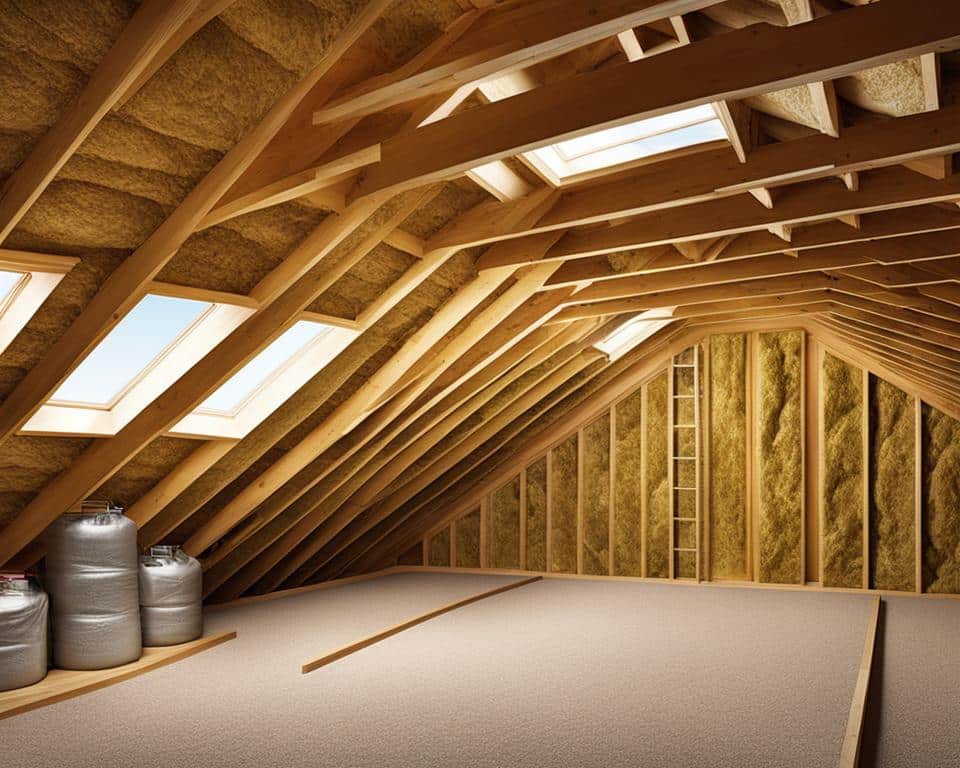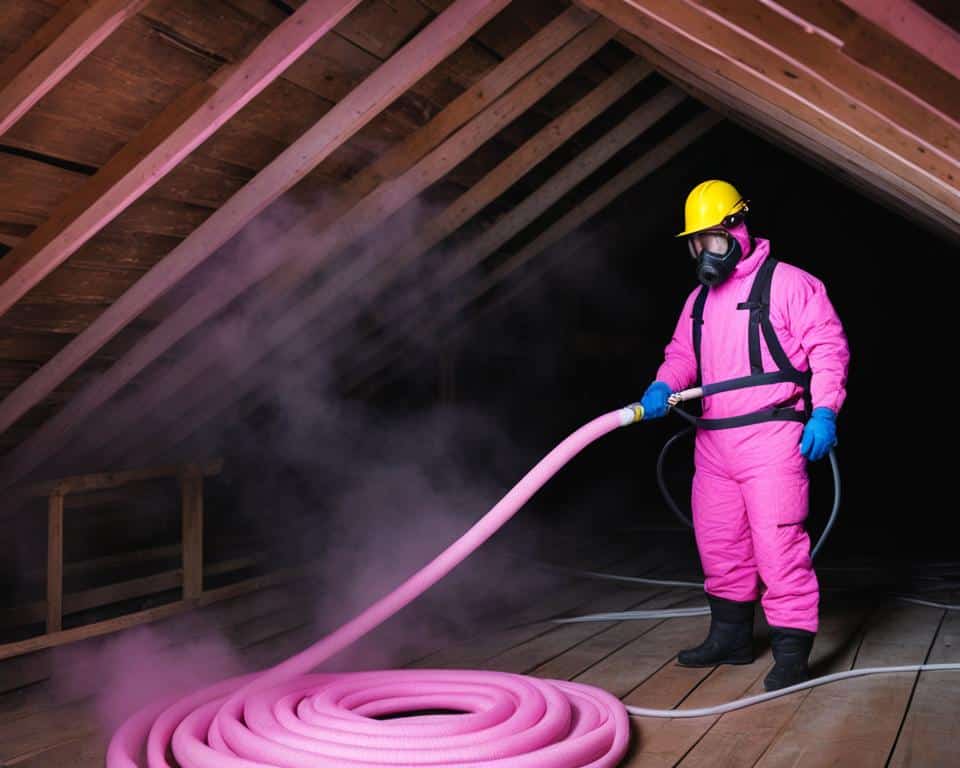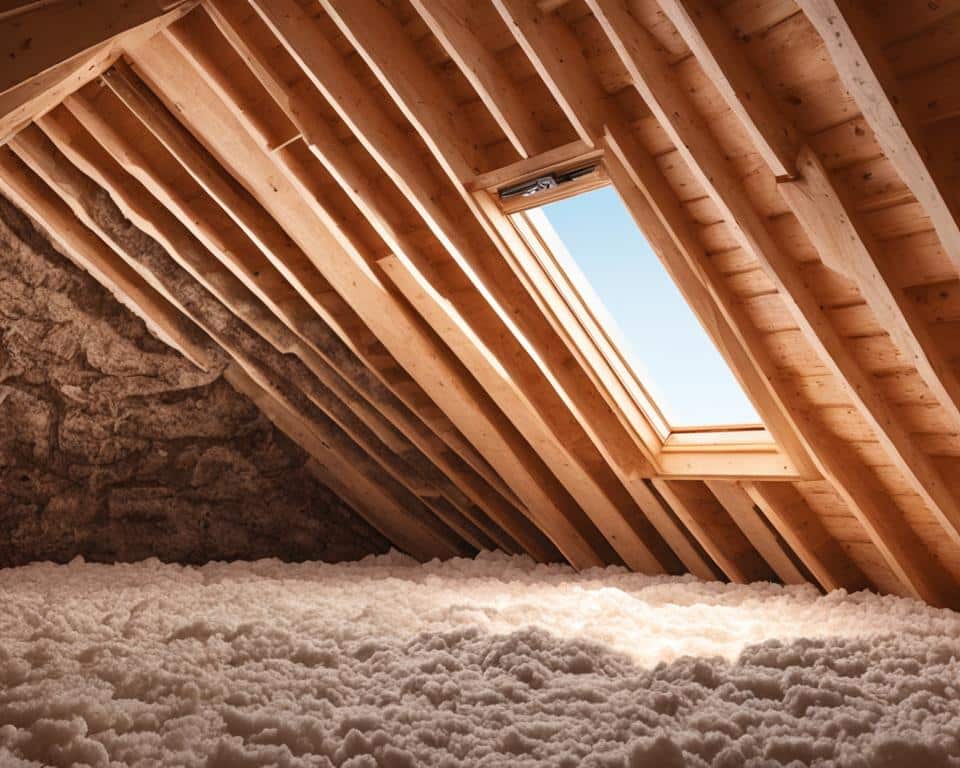Welcome to our article on free loft insulation. Today, we will be discussing whether free loft insulation is truly “free” and uncovering any potential hidden costs associated with this offer. In the United Kingdom, one organization that offers free loft insulation is Ecowise Installations.
Free loft insulation is a common initiative aimed at promoting energy efficiency in UK homes. However, it’s important to understand that while the loft insulation itself may be free, there may be other costs involved. These costs can include installation fees or meeting specific eligibility criteria set by the provider.
Before opting for free loft insulation, it is crucial to carefully read the terms and conditions and understand any potential limitations or obligations. By doing so, you can ensure that you make an informed decision and avoid any surprises along the way.
Table of Contents
ToggleKey Takeaways:
- Promotions for free loft insulation are common in the UK to promote energy efficiency.
- While the loft insulation itself is free, there may be other costs involved, such as installation fees or eligibility requirements.
- It is important to read the fine print and understand any limitations or obligations before opting for free loft insulation.
- By making an informed decision, you can ensure that you fully benefit from the offer and avoid any hidden costs.
- Consider the long-term benefits of loft insulation, such as improved energy efficiency and reduced energy bills.
Understanding Loft Insulation: Materials and Benefits
When it comes to loft insulation, selecting the right materials is crucial for maximizing energy efficiency and reducing heat loss. Commonly used loft insulation materials include mineral wool, cellulose, and polyurethane foam. These materials offer excellent thermal resistance, helping to retain heat within your property and lower energy consumption.
Mineral wool, also known as rock wool or glass wool, is a popular choice due to its affordability and effectiveness in reducing heat transfer. It is made from natural materials such as basalt or recycled glass, providing good insulation properties.
Cellulose is another widely used material for loft insulation. It is made from recycled paper or plant fibers treated with fire retardant chemicals. This eco-friendly option offers excellent thermal performance and helps to improve energy efficiency.
Polyurethane foam insulation, often applied as a spray or rigid foam boards, provides superb insulation with minimal thickness. It is known for its excellent thermal conductivity properties and can be used to insulate hard-to-reach areas or irregular shapes in the loft space.
Benefits of Loft Insulation
- Improved Energy Efficiency: Loft insulation acts as a barrier, preventing heat from escaping through the roof. This reduces the need for excessive heating, resulting in lower energy consumption and cost savings on your energy bills.
- Reduced Heat Loss: Properly insulated lofts minimize heat loss, helping to maintain a comfortable temperature within your home. This is especially important during colder months when adequate insulation can prevent cold drafts and maintain a cozy environment indoors.
- Lower Energy Bills: By retaining heat and reducing the demand for heating, loft insulation can lead to substantial savings on your energy bills. Investing in insulation can provide long-term financial benefits for homeowners.
- Increased Comfort: Insulated lofts create a more comfortable living space by regulating temperature fluctuations. With effective insulation, you can enjoy a consistent and cozy environment year-round.
- Reduced Environmental Impact: Properly insulated homes contribute to reducing carbon emissions and the overall environmental impact. By using less energy for heating, you can play your part in mitigating climate change.
Understanding the materials used in loft insulation and the associated benefits can help you make informed decisions about improving the energy efficiency of your home. To achieve optimal results, it is advisable to seek professional advice and installation services.
Exploring the Types of Loft Insulation
When it comes to loft insulation, there are several types to consider. Each type has its own unique features and benefits. Let’s take a closer look at the different loft insulation options available:
1. Blanket Insulation
Blanket insulation, also known as matting, is the most common type of loft insulation. It consists of rolls or batts made from materials such as mineral wool or fiberglass. Blanket insulation is easy to install and suitable for most loft spaces. It provides excellent thermal resistance, helping to retain heat and reduce energy consumption in the home.
2. Loose-Fill Insulation
Loose-fill insulation is another popular choice for loft insulation. It is made up of loose granules or fibers that can be blown or poured into the loft cavity. This type of insulation is ideal for irregularly shaped or hard-to-reach areas. It fills gaps and voids effectively, providing good thermal and acoustic insulation properties.
3. Rigid Insulation
Rigid insulation boards are more rigid and provide effective insulation with minimal thickness. They are often made from materials such as expanded polystyrene (EPS), extruded polystyrene (XPS), or polyisocyanurate (PIR). Rigid insulation boards are lightweight, easy to handle, and offer excellent thermal performance. They are commonly used in new constructions or when additional insulation is required in limited space.
Choosing the best type of loft insulation depends on various factors such as the type and size of your loft space, your budget, and your specific insulation performance requirements. It is recommended to consult with professionals, like Ecowise Installations, who can assess your needs and provide expert guidance on the most suitable loft insulation solution for your home.
To give you a better idea of the different types of loft insulation, here is an image illustrating the different materials used:

Understanding the types of loft insulation available will help you make an informed decision when it comes to improving your home’s energy efficiency and reducing heat loss.
Understanding the Cost of Loft Insulation
When it comes to loft insulation, it’s important to have a clear understanding of the costs involved. The overall cost of a loft insulation project can vary depending on several factors.
Firstly, the size of your property will play a significant role in determining the cost. Larger properties will generally require more insulation material, resulting in a higher cost. On the other hand, smaller properties may cost less due to the reduced amount of insulation required.
The type of loft insulation material you choose will also impact the cost. Different materials have varying price ranges, but it’s crucial to select a high-quality material that provides effective insulation.
Additionally, the complexity of the installation can affect the cost. If your loft has any unique features or challenging access points, it may require more time and effort to complete the insulation project, resulting in higher costs.
On average, a standard loft insulation installation can typically range from £300 to £500. However, it’s important to note that these costs may vary depending on the factors mentioned above.
While the upfront cost of loft insulation may seem significant, it’s essential to consider the potential savings in energy bills over time. By properly insulating your loft, you can reduce heat loss, improve energy efficiency, and ultimately lower your energy consumption. These long-term savings make loft insulation a worthwhile investment for homeowners.
The Process of Loft Insulation Installation
When it comes to loft insulation installation, a systematic approach ensures efficient and effective results. At Ecowise Installations, we follow a streamlined process to ensure that your loft is properly insulated, providing you with all the benefits that come with it.
Assessment of the Loft Space
Before proceeding with the installation, our team conducts a thorough assessment of your loft space. This includes inspecting the dimensions, layout, and any existing insulation. By understanding the unique characteristics of your loft, we can determine the most suitable insulation materials and installation techniques.
Preparation of Insulation Materials
Once the assessment is complete, we prepare the insulation materials based on the specifications of your loft. This involves cutting the insulation to the appropriate size and ensuring that it is ready for installation.
Installation in the Loft Cavity
With the materials prepared, our team carefully installs the insulation in the loft cavity. This may involve laying or fitting the insulation between and over the rafters, covering the entire loft space. We ensure that the insulation is properly positioned and secured, maximizing its effectiveness.
Professional Assistance for Complex Layouts
In some cases, loft spaces may have complex layouts or hard-to-reach areas. Our experienced installers are equipped to handle such challenges, ensuring that every corner of your loft is properly insulated. Their expertise and attention to detail guarantee an installation that meets the highest standards.
Compliance with Building Regulations
At Ecowise Installations, we prioritize compliance with building regulations to ensure the safety and quality of your loft insulation. Our team follows the necessary guidelines and standards throughout the installation process, giving you peace of mind.
When it comes to loft insulation installation, hiring accredited installers like us is crucial. With our expertise, we provide a seamless experience, from assessment to installation, ensuring that your loft is effectively insulated. Experience the benefits of proper insulation with Ecowise Installations.

Loft Insulation Grants and Funding Options
There are various grants and funding options available in the UK to support the installation of loft insulation. These include government schemes such as the Energy Company Obligation (ECO) and the Green Homes Grant. These grants aim to provide financial assistance to eligible households to improve energy efficiency and reduce carbon emissions.
One of the organizations that offer these grants is Ecowise Installations. They are dedicated to helping homeowners access funding for loft insulation projects, ensuring that more households can benefit from energy-saving measures.
If you’re interested in applying for loft insulation grants, it is advisable to check the eligibility criteria and application process for these grants to make the most of available funding opportunities. Eligibility criteria may include factors such as income levels, property types, and energy efficiency goals.
By taking advantage of loft insulation grants, you can make your home more energy-efficient, reduce your carbon footprint, and potentially save money on energy bills in the long run.
When considering loft insulation, it’s important to explore the available funding options and take advantage of grants that can help offset the costs. Grants like the Energy Company Obligation (ECO) and the Green Homes Grant are designed to promote energy efficiency and make loft insulation more accessible to homeowners. By understanding these funding options and meeting the necessary criteria, you can take a step towards a more energy-efficient home.
Common Misconceptions about Loft Insulation
When it comes to loft insulation, there are a few misconceptions that have circulated. It’s important to debunk these misconceptions to ensure homeowners have accurate information and can make informed decisions. Let’s address two of the common misconceptions.
Loft Insulation Benefits All Climates
One misconception is that loft insulation is only beneficial in colder climates. However, this couldn’t be further from the truth. Loft insulation plays a crucial role in regulating temperature throughout the year, ensuring that homes stay cool during the summer months and warm during the winter season. By preventing heat from escaping during colder months and minimizing heat gain during warmer months, loft insulation offers year-round comfort and energy efficiency.
Properly Installed Loft Insulation Does Not Cause Condensation Issues
Another misconception is that loft insulation causes condensation problems. It’s important to note that when loft insulation is installed correctly and the property has adequate ventilation, condensation issues should not arise. Properly ventilated attic spaces allow for the passage of moisture vapor, preventing it from being trapped against cold surfaces. This helps maintain a healthy and moisture-free environment within the home.
By debunking these common misconceptions about loft insulation, homeowners can make informed decisions about improving their home’s energy efficiency and comfort. It’s essential to rely on accurate information and consult with professionals like us at Ecowise Installations to ensure the best insulation solution for your specific needs.
DIY vs Professional Loft Insulation Installation
When it comes to loft insulation, some homeowners may consider a DIY approach to save on costs. While the idea may seem appealing, it’s crucial to understand the complexities and potential risks involved. Loft insulation requires proper insulation coverage and adherence to building regulations to ensure optimal performance. That’s where professional loft insulation installation comes into play.
Professional loft insulation installation provides several key advantages:
- Expertise: Accredited installers, like Ecowise Installations, have the knowledge and experience to assess your specific requirements and recommend the most suitable loft insulation solution.
- Quality and Efficiency: Professionals ensure that the loft insulation is installed correctly, maximizing its effectiveness and energy-saving potential.
- Adherence to Building Regulations: Professional installers are familiar with the regulations and guidelines that apply to loft insulation, ensuring your project meets the necessary standards.
- Guarantees: Many professional installers offer warranties or guarantees on their work, providing peace of mind that any issues will be addressed promptly.
While DIY loft insulation may initially seem cost-effective, the potential risks and complications that can arise from improper installation may end up costing you more in the long run.
For the best outcome and to ensure a properly insulated loft, it is recommended to consult with experts and accredited installers, like Ecowise Installations. They can guide you through the process, address any concerns you may have, and provide professional loft insulation installation that meets your specific needs.
Maintenance and Upkeep of Loft Insulation
Proper maintenance and upkeep of loft insulation are essential to ensure its effectiveness and longevity. Regular inspections can help identify any issues such as damage or signs of dampness. It is important to keep the loft space well-ventilated to prevent moisture buildup. Additionally, maintaining the loft insulation’s integrity by avoiding unnecessary disturbance or compression is crucial for optimal performance.
Regular inspections are key to identify any potential problems with your loft insulation. Look for signs of damage or deterioration, such as tears, gaps, or sagging insulation. If you notice any issues, it’s important to address them promptly to prevent further heat loss and reduce energy efficiency.
Signs of Damage or Dampness
During inspections, pay close attention to any signs of damage or dampness. This can include water stains, mold growth, or a musty smell. Dampness can compromise the insulation’s effectiveness and lead to potential health issues if left unchecked. It is crucial to identify the source of moisture and address it before repairing or replacing the insulation.
Maintaining Ventilation
Proper ventilation is crucial for the health of your loft space and the effectiveness of your insulation. It helps control moisture levels, prevent condensation, and reduce the risk of mold growth. Make sure that your loft space has adequate ventilation, such as vents or windows, to allow for fresh air circulation. Avoid blocking airflow by covering or obstructing vents.
Safeguarding the Insulation’s Integrity
When it comes to maintaining loft insulation, it’s important to safeguard its integrity by avoiding unnecessary disturbance or compression. Constantly walking or placing heavy objects on the insulation can compress it, reducing its effectiveness. Additionally, avoid storing items directly on the insulation, as this can cause damage or create uneven insulation coverage. Use raised platforms or boards to create a storage area above the insulation, keeping it protected.
By following these maintenance tips, you can ensure that your loft insulation remains in good condition and continues to provide effective thermal resistance. Regular inspections, ventilation management, and safeguarding the insulation’s integrity will contribute to a more energy-efficient and comfortable living environment.
Conclusion – Making Informed Decisions about Loft Insulation
When considering loft insulation, it is crucial to make informed decisions that take into account various factors. We should carefully weigh the benefits, potential costs, eligibility criteria, and available funding options. By understanding the different types of loft insulation and considering professional installation, we can improve energy efficiency, reduce heat loss, and create a more comfortable living environment.
One key aspect to consider is the choice of insulation material. The selection should be based on factors such as the type and size of the loft space, budget, and insulation performance requirements. Understanding the pros and cons of each material, such as mineral wool, cellulose, or polyurethane foam, can help us make the right decision.
Moreover, when it comes to loft insulation, opting for professional installation is highly recommended. Accredited installers, like Ecowise Installations, have the expertise and knowledge to ensure proper insulation coverage and compliance with building regulations. This guarantees the effectiveness and long-term performance of the insulation, giving us peace of mind.
Lastly, regular maintenance and upkeep of loft insulation are essential. By conducting routine inspections and keeping the loft space well-ventilated, we can prevent potential issues such as damage or dampness. Avoiding unnecessary disturbance or compression of the insulation also helps maintain its integrity and overall performance.



